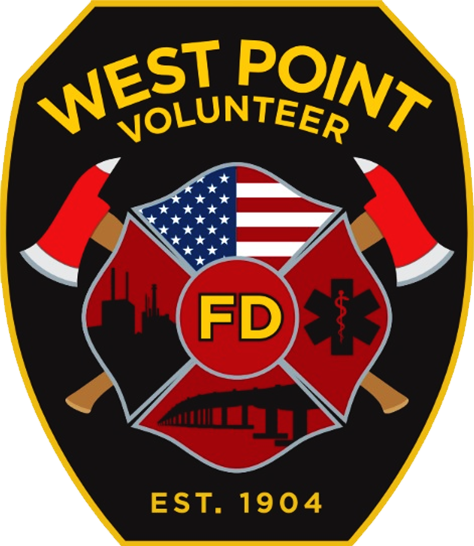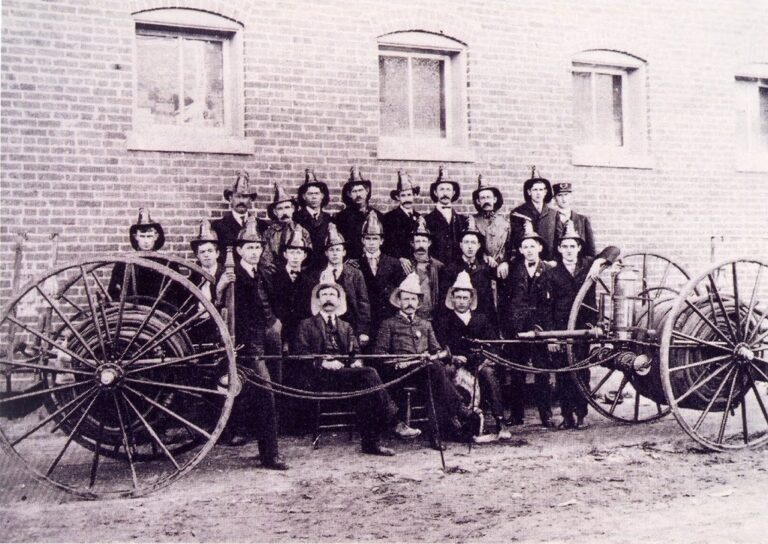The history of American cities and towns often is written in flame. Before modern innovations in heating, lighting, and cooking technologies, frame structures and open flames frequently united with disastrous results. The nineteenth and early twentieth centuries witnessed an unrelenting chronicle of massive urban fires, of which those that devastated Chicago, Baltimore, and San Francisco are only the best known. Small towns were equally susceptible to destructive fires, and West Point, Virginia, discovered this to be the fact on the night of August 31, 1900.
A blaze broke out in the Burwell Brothers grocery store on Seventh Street, spreading to the entire block and culminating in the loss of a dozen structures. Three days later the West Point Town Council entertained a motion that a “committee be appointed to look after the fire protection of the town” and, the following month, money was appropriated for the hook and ladder brigade to be equipped with two 16-foot ladders, one dozen axes, and twenty-five galvanized fire buckets. John D. Elms, an oysterman, was named as the chief. Therefore the establishment of West Point’s Volunteer Fire Department dates to this action of the Town Council on October 1, 1900. (Palmer, 2014, p. 5)
1870’s - 1900's
1870
West Point is Incorporated as a Town
West Point was settled by English colonists in the 1650’s but was incorporated as a town in 1870.
November 29, 1880
The Shirley
The Shirley (a 600-ton vessel) burst into flames. A stiff breeze blew burst embers to the docks causing nearby sheds and warehouses to go up in flames.
By daylight, six large warehouses, 2600 bales of cotton (223 on the vessel), 21 railroad cars carrying all types of freight, the railroad’s offices, and the telegraph office were destroyed. Only a timely rainstorm saved the town from falling embers. No lives were lost, but the damages were estimated at a quarter million dollars.
December 26, 1881
The Explosion of the West Point
The West Point’s (formerly the Shirley’s) cargo included fertilizer, compressed hay, several hundred barrels of kerosene, and sixty barrels of gasoline. When the vessel arrived at the docks of West Point, Virginia, the fumes of the cargo and an open flame lantern created an explosion.
The explosion blew out the forward portion of the deck and a large part of the West Point’s starboard side. Every man below deck died instantly; others were thrown into the river, where they drowned or were killed by falling debris. People nearby on the dock were badly burned.
The explosion and results of the fire took 19 lives and injured many more.
November 11, 1886
Another Ship Afire
The burning Alice M. Minot, loaded with cotton, was towed from the Pamunkey River docks by the tug Claribel. The burning ship was scuttled to quench the fire. It was later raised, but its cargo was ruined.
July 14, 1887
Town Council Meeting
The Town Council was aware of the town’s danger of fire to the community. They requested the mayor to look into purchasing a hook and ladder for fire extinguishing purposes.
The Town Council’s meeting minutes, are unclear about whether this was done.
1888
Fire Committee is Formed
In April, the mayor appointed a committee of three to take into consideration and report a plan for the protection of property against fire. Messrs. A. W. Eastwood, B. N. Robinson, and R. S. Dudley were appointed.
On June 11, the committee reported that what the town needed was more than firefighting equipment; it needed a fire department.
1894
Vote for Money to Start a Fire Department
Five years after the report from the committee, the town proposed a referendum to create a municipal water supply. It was shot down by the community because of the concern about a huge tax increase.
1900
Town Fire & Start of Hook & Ladder
The town of West Point relied on the fire company organized by the Richmond and Danville Railroad, which was responsible solely for the railroads and the river wharves.
When a fire erupted on Seventh Street, on August 31, 1900, the fire company was not there to put it out as there was neither a municipal fire company nor an adequate public water supply to fight the fire. Buildings, small houses, and fences were burned or torn down to stop the fire. Hard work from the citizens and a timely change of wind stopped the flames.
This fire prompted the town council to establish a hook and ladder brigade on October 1, 1900. John Elms was appointed Chief.

Content provided by William Palmer
William A. Palmer, Jr. was the eleventh sworn chaplain of the West Point Volunteer Fire Department., having served in that role from 2012 to 2022. An ordained clergyman in the Christian Church (Disciples of Christ), he was endorsed for chaplaincy by that denomination and is a member of the Federation of Fire Chaplains.

